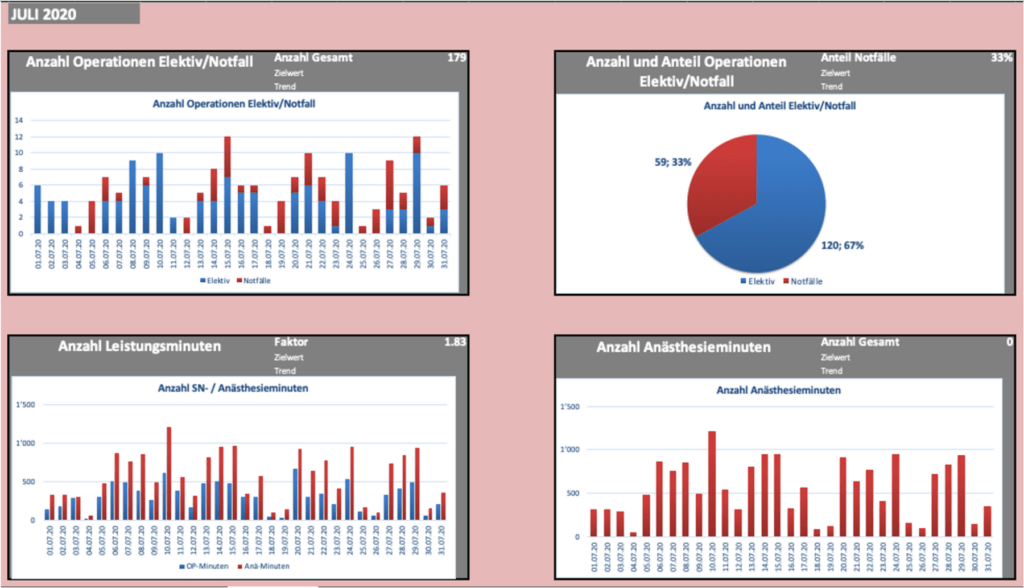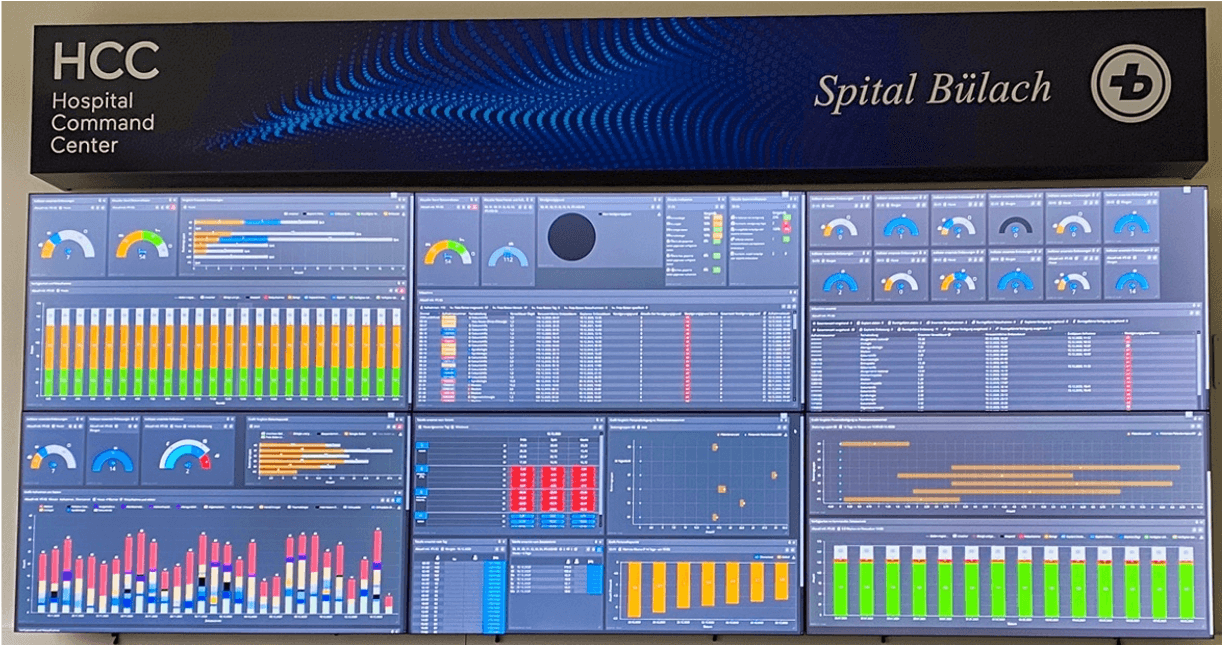
The modern operating room – the key to success
Best practices are increasingly moving towards defining the OR as an interdisciplinary and interprofessional service platform. In order to optimise the decision-making and improvement process in the OR on this platform, the following blog post proposes solutions that take into account the needs of the different stakeholders.
An article by Prof. Dr. med. Gian A. Melcher, Senior Medical Expert walkerproject ag, specialist in surgery, focus on visceral surgery, general and trauma surgery.
The operating room area is confronted with a variety of challenges in everyday life. Originally controlled primarily by the surgeon, the operating room has become a service platform run by many professional groups. In addition, the influence of hospital administration on this platform is also increasingly visible. Stable management and reliable planning ensure a balance in this personnel- and cost-intensive hospital area. Various solutions are intended to improve the quality of care, patient orientation and the structure and efficiency of internal processes. Solutions are presented for the following areas:
- Data-based control and management
- Operating room planning
- Patient orientation and efficiency
Data-based control and management
The establishment of a broad-based, platform-specific OR controlling system provides the OR management team with an objective control and management tool. In many ORs, however, such an instrument does not exist at all or is only poorly structured. The following step-by-step procedure is recommended for setting up OR controlling:
- Elaboration of standardised key figures based on best practices
- Definition of corresponding target values
- Frequency and responsibility of the survey
- Process for measuring the key figures
- Measures to be taken in case of divergence from the defined target values

The key figures allow a differentiated observation and interpretation of the processes in the OR. This should be the basis for transparent and well-founded decision-making and thereby also stabilises the OR management boards.
Experience shows that the quality of management in a complex business is highly dependent on the individual. The principle of delegation is sometimes weakly developed and is therefore exercised differently. With a three-level management system, tasks and competences can be allocated in a meaningful way. The following management levels can be defined as a possible example:
- Operating room commission
- Operating room management
- Operating room manager / coordinator
The OR commission consists of a broadly supported committee integrating various professional groups (including the corresponding representatives of the attending physicians). It defines the general processes and standards, derives measures from the data of the OR controlling, defines the long-term OR planning and is responsible for the regular revision of the OR status.
The operating room management is made up of a small group of people who are as competent as possible to make decisions (e.g. senior physicians in surgical fields, senior physicians in anaesthesia and representatives from the nursing staff). Together they decide on the medium-term allocation of operating room slots and the procedure to be followed in the event of staff shortages. It also acts as a “platform police” in the event of repeated non-compliance with standards.
The operating room management/coordination is responsible for the day-to-day management and coordination. They have, for example, the following competences: merging or closing operating slots at short notice, changing the order of the operating rooms or postponing an operation. They also keep track of the overtime situation of the staff. As a member of the operating room management, they consult with colleagues from the operating room management as much as possible when difficult decisions have to be made.
With a clearly defined and broadly supported leadership system, a higher impact can be achieved. Thanks to bindingly defined roles and the allocation of tasks and competencies, a replacement can also follow a clear line. Commitment is promoted and the right incentives are set with sanctions in case of non-compliance with a standard.
OR planning
Long-term reliable and also economic OR planning usually fails for various reasons. Often the OR planning is very surgeon-friendly, meaning that each surgeon or surgical unit has an entire room per day, even with (temporarily) low workloads. The scheduled operating times are unreliable or the definition of emergencies is not standardised. A particular challenge is also the mix of internal surgeons and affiliated doctors.
First of all, it is important to consider the operating room as part of an overall system. This means that capacity management in the OR must also necessarily take into account the capacities of upstream and downstream areas, primarily the ward. Often the initial situation is an overcapacity of operating room slots and an undercapacity of beds on the ward or in the day clinic. Operating room and bed planning are very closely related, so only a mutual adjustment of capacities and a reduction of fluctuations in both areas is helpful for the overall system.
Long-term planning of operating room slots must generally be more data-based and less surgeon-centred. The method of “resource scarcity” offers a way to optimise OR utilisation. Here, operating room slots of different lengths (according to the resources actually needed) are allocated: slots that run the whole day (e.g. 8:00 a.m. to 3:30 p.m.), but also slots that run for half a day (e.g. 8:00 a.m. to 12:00 p.m. and 12:30 p.m. to 3:30 p.m.). This frees up capacities that may be needed in different ways: (short-term) release for other surgeons, processing of emergencies or late registrations or a reduction of overtime.
Patient orientation and efficiency
Some very traditional elements in OR practices (e.g. forms of anaesthesia, patient involvement) create poor conditions for a patient-centred OR process. Patient orientation is created by secure planning, reliability of (OR) appointments, no waiting times and patient safety (e.g. team time-out or regulations on antibiotic prophylaxis and hygiene).
The principle of Same Day Surgery (SDS) with an operation on the same day as the hospital admission day has gained massively in importance in recent years. This increases patient satisfaction and the capacities on the wards or in the day clinic. However, a requirement for this in many places is a revision of the admission process with a functioning and high-quality preoperative assessment (PAS). Ideally, the PAS should be tailor-made and risk-adapted and, in “uncomplicated” cases, can take place directly after the consultation appointment (“one-stop-shop”). The premedication and further check-ins are carried out in one go and a further appointment becomes unnecessary. Under certain circumstances, the possibility of a telephone / telemedical assessment should also be considered. On the other hand, “complex” patients can only be assessed in an elective setting after a possible additional internal examination with a justifiable risk.
Further concepts such as “walking to the operating room” or “(reclining) chair instead of bed in the day clinic” can be developed. The former indicates for certain patient clusters that the patient is accompanied to the operating room on foot. This makes it possible to slim down the pre-operative process considerably. With the “chair instead of bed in the day clinic” concept, the capacity of the day clinic is significantly increased, the bed preparation effort and the patients’ length of stay are reduced and, as a rule, patient satisfaction is increased at the same time.
A proactive patient management together with a high level of communication, transparency and a good operational culture will meet the needs of patients as well as staff and ensure that the OR will achieve a high level of efficiency also in the long term.



